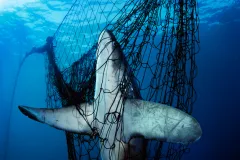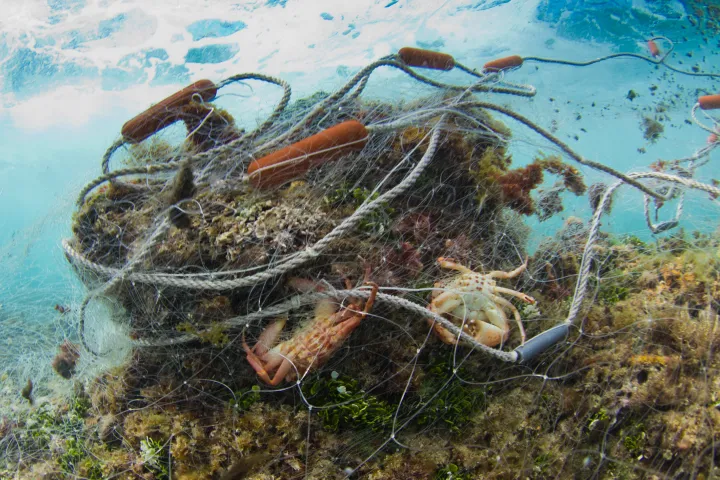Good-Bye Gillnet, Hello Shark Recovery!

Imagine that you're a shark swimming beneath the surface, minding your own business, when—smack!—you swim right into a net. Entangled, you are unable to keep swimming forward to draw water over your gills and are unable to breathe. Surprising as it may seem, a simple nylon net can stop a shark in its tracks, especially a juvenile or baby shark.
This is not a pretty picture, but it's the fate of many sharks and other animals that encounter gill nets. Sometimes called "curtains of death," gill nets have floats at the top and weights at the bottom so that they hang vertically in the water, often stretching for miles.
In the 1980’s and 1990’s, gill nets became very popular among commercial fishers in Southern California because they were effective at catching large valuable fish like halibut and sea bass. Unfortunately, they were equally effective at entangling sharks, sea lions and dolphins—species that were not meant to be caught. Any animal unintentionally caught that cannot be used is called bycatch. Bycatch is not kept, sold or eaten but rather thrown away.
As gill nets became popular, top predators—big fish and sharks—began to dwindle in the area. From 1982 to 1997, soupfin shark and leopard shark populations declined dramatically and, by 1981, white seabass populations had collapsed to only 10 percent of historic levels.
It seemed that the gill nets were to blame. Close to the shore, the gill nets targeted important gathering spots where sea bass came to reproduce. Similarly, female sharks used the shallow waters to birth their young pups. By targeting these locations, the gill nets were making reproduction harder and hindering the maintenance of the population as a whole.
The decline of these populations birthed an unlikely partnership between environmental activists and sport-fishers, groups that don’t always see eye-to-eye. Southern California is a common destination for recreational fishing, attracting over a million sport-fishers to the area to seek out sea bass, swordfish and halibut. These fishers were disappointed that their favorite big fish were becoming less and less common where once they were abundant.
In 1990, the sport fishers and activists rallied together to collect the 600,000 signatures necessary to put Proposition 132 on the ballot in California. Come Election Day, local people were given the opportunity to vote on whether near-shore gill nets should be banned in Southern California. It passed with 55 percent of the vote! In 1994, the state banned gill nets within three miles of the mainland and one mile of the offshore islands.
Originally intended to protect the white seabass population that came close to the shore to spawn, the gill net ban was even more successful than intended. Small leopard sharks and soupfin sharks, unseen since 1995, returned to the area. White shark populations grew, especially the population of young sharks. By 2003, 21 years after receiving protected status, the sea bass fishery rebounded to historic pre-collapse levels. And despite initial concerns about the regulations, commercial fishers welcomed the ban once they started pulling in larger catches of sea bass with less effort further from shore.
With the nearshore ban protecting sharks within three miles of land and federal protections beyond three miles of the shore, California is among the leaders in shark protection around the world. But there is always room for improvement; some believe that gill nets should be a thing of the past altogether. What is clear is the 1994 movement to ban gill nets from important nearshore habitats was a resounding success by committed anglers and average citizens working together.


